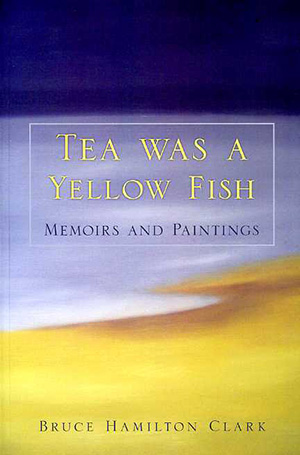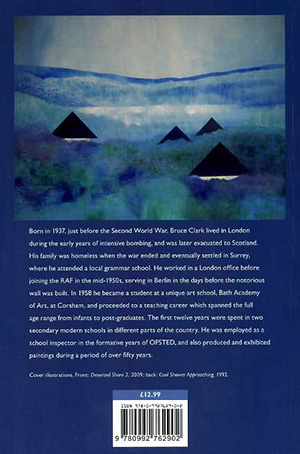 home
about
artists
exhibitions
press
contact
purchase
home
about
artists
exhibitions
press
contact
purchase |
|
|
Bruce Hamilton Clark 'Tea Was A Yellow
Fish. Memoirs and Paintings'
Extract from the book: The Art World: Galleries and Exhibitions I was not alone in becoming disillusioned early on with the commercial gallery system. Over the years I have only come across a handful of dealers I could trust. Many made promises they did not keep, and only a few seemed prepared to step outside a narrow concept of what they felt sure would bring them lucrative sales. Sometimes there would be two people making decisions: inevitably one would be for and the other against. In the early days I kept away from the normal system by joining various groups of artists in London, including the Free Painters’ Group and through that the International Association of Plastic Arts. My first solo exhibitions were courtesy of the Taurus Artists, a group formed by the Hungarian artist Endre Boszin. I well remember the occasion at the Chiltern Gallery when I had delivered my paintings by car and had left it parked outside. Unfortunately it was opposite a fire station and within minutes I was confronted by an enormous fireman and a threat of police involvement if I did not disappear immediately. Many years later I remember a dealer being treated badly. The Raw Gallery, one of the more open establishments, was invited to mount an exhibition, including some of my work, at the West End Business Centre. It was assumed it would run for a normal period of time but they had to take it down again the next day. It had merely been decorating the walls for a single function. One of my own worst experiences was when a dealer at the Thackeray Gallery showed great interest in the material I had sent her and asked me to deliver a selection of paintings. I drove some 60 miles, including across London, to arrive for a specific appointment the next day. She was not there. A receptionist advised me not to unwrap the paintings. I waited an hour during which I had to feed a parking meter. When the dealer finally arrived it was obvious that she had no intention of giving the work more than a cursory glance under pressure: no reason given. Another time I went to London to collect a single painting from a gallery, the name of which I cannot remember. I was warmly welcomed with a glass of sherry and presented with the work neatly wrapped. When I arrived home I discovered that the frame had been badly damaged. The biggest disappointment of all was in connection with a Mayfair gallery. One day, in 2009, I was walking up and down Cork Street looking at all the exhibitions as I often did. In the Hay Hill Gallery, Mikhail, a Russian dealer, asked me what I thought of the exhibition. The conversation continued for some time and he discovered something of my background, including where I had studied and with whom. To my utter amazement he eventually asked me if I would be interested in putting on an exhibition, and invited me to send my CV and photographs of work. This I did; feeling it was something of a breakthrough. When a reply came, it was not from Mikhail but from his colleague, an American dealer called Gary, who again to my surprise, was prepared to travel to Cambridgeshire to view my work. The outcome of this visit was that he liked some paintings but not others, parts of some paintings but not other parts. Nevertheless he decided to take three paintings away with him. In due course arrangements were made for an exhibition, including dates, but I was asked to produce a new series of landscapes, clad in expensive frames. This involved a very intensive period of work but I managed to meet the deadline with twenty one works ready in time. I was to be showing alongside a Russian artist, Stanislav Plutenko, and also Rodin, as the gallery owned some posthumous casts of his sculptures. In the meantime, when I was in Mayfair to finalise some of the arrangements, Gary came in having just viewed a larger gallery which had become available across the road. On his insistence, Mikhail, without showing any great enthusiasm, went across to look at it and came back agreeing, as he put it, that it was a nice ‘premise’. I was to learn later that they had indeed acquired the property, and the timing was such that my work would be part of the first exhibition there. This was where things began to go drastically wrong. The move took longer than expected, with a great deal to be done, and there was some disagreement as to how the work should be arranged within the different proportions of the available space. In the event I was to share the lower floor with the Russian artist, whose large realist but highly imaginative works were never going to sit happily alongside my smaller abstracted landscapes. The upstairs space was now to be occupied by another English landscape painter, William Foreman. The initial publicity was good, but by now two weeks of the allotted time had been lost and there was to be no private view. However, I was very pleased with the way Mikhail hung my work, and felt that it stood up quite well alongside some of the superb Rodin sculptures. Mikhail then went off on one of his regular trips to Russia. Once the whole exhibition was at last up and running, to add to my mounting misfortunes, a visitor or visitors made some remarks to the effect that he, she or they, liked the Russian paintings but not mine. This was enough for Gary who, perhaps with an eye on potential sales, and without informing me, took it upon himself to remove my work just before the scheduled end of the exhibition, and substitute some more Plutenkos. If I had not called in at that point I would never have known, which was no doubt the intention. With the dates curtailed at both ends, I had little chance of success, but the exercise had cost me around £2,000 for framing and transportation. It soon became obvious that Gary had intended all along to go upmarket in the new premises, dealing only with very big names. Warhol was followed by Dali and so on. There was clearly no future for the likes of me. I understood that some of the other exhibitions intended for the original gallery were cancelled altogether, no doubt leading to even greater disappointment. The whole experience just seemed to sum up my many trials and tribulations within a volatile art market over the years. However, since then Mikhail and Gary have parted company and Mikhail has relocated to Baker Street, still using the name ‘Hay Hill Gallery’. He has now offered me the possibility of participation in group exhibitions, and so remains one of the few dealers in whom I have some faith. I was successful on three occasions with my submissions to the Royal Academy Summer Exhibition. The year the work was sold I was surprised to find that in spite of the entrance fee and 33 per cent commission I had to handle the sale myself. I no longer sent paintings once the Academy tried to enhance their reputation by inviting ‘celebrity’ artists to fill large areas of the space available. This in addition to allowing members of the Academy guaranteed inclusion of six works, even though some of them were submitting virtually identical paintings year after year. Again the odds against artists like me had become ridiculous. We were simply subsidising the others. Many artists, including some very famous ones, have had a hatred of critics. I cannot complain very much on that score. When my paintings have been reviewed I have generally fared quite well. Sometimes though, without being scathing about work, they can prove less than helpful! My younger son, who is a journalist, gave a postcard of one of my landscapes to Brian Sewell, inviting him to a forthcoming exhibition. He said, ‘That’s very nice; I shall put it on my mantelpiece and do absolutely nothing about it.’ Thankfully not every experience has been negative - most exhibitions have run smoothly enough, if not always proving as lucrative as one would like. It was a gallery in Dover, owned by an ex-teaching colleague, which probably attracted the most sales, with paintings on show regularly and purchasers often acquiring more than one work. In 2011, as a new member of Cambridgeshire Open Studios, I welcomed visitors to the house. I had not joined the equivalent organisation in Kent, for although I had an impressive studio, I felt it was too isolated to attract many visitors. Now, although I enjoyed a suitable location, my studio was a converted bedroom on the third floor, so I had to organise an appropriate space at ground level. The inconvenience of this, and the number of people who came over the three weekends did not encourage me to make it an annual event, but I did have some very interesting conversations with a wide variety of people. Some were very knowledgeable concerning art, others not so well informed. I told one man who was enquiring about a particular painting that it was a purely imaginative landscape, not a specific place. ‘Is that allowed?’ he asked! All things considered, my most successful exhibition was probably the large retrospective which I hung myself, and again, had to be in attendance throughout, as the venue was a large arts centre as opposed to a private gallery. I was able to add captions below every painting explaining how it had come about. I had many favourable comments on this, and visitors felt able to ask further questions within a much more relaxed atmosphere than most galleries can offer. The event was very well attended: obviously there were some visitors who had initially arrived to attend some other event at the centre but wandered in out of curiosity. The photographs of paintings which follow this chapter also have captions, which hopefully will explain the initial inspiration, and how each relates to the account given here. |
|
|
|
return
|

